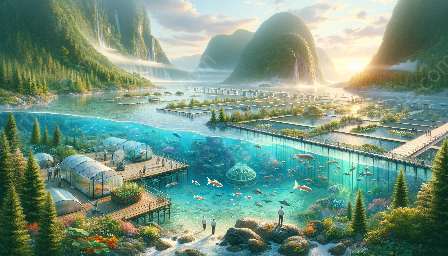Aquaculture, an integral part of fisheries science and applied sciences, plays a crucial role in meeting global food demand. However, ensuring the health and sustainability of aquatic organisms in aquaculture operations necessitates a comprehensive approach to biosecurity. In this topic cluster, we will delve into the significance of biosecurity in aquaculture, explore the key challenges, and discover innovative strategies to mitigate risks and promote a thriving aquaculture industry.
The Significance of Biosecurity in Aquaculture
In aquaculture, biosecurity refers to the set of management practices and measures aimed at preventing the introduction and spread of infectious diseases, parasites, and invasive species. The implementation of robust biosecurity protocols is essential for safeguarding the health and welfare of fish and other aquatic organisms, as well as for maintaining the ecological balance of aquatic environments.
Effective biosecurity not only protects the aquaculture operations from potential disease outbreaks but also contributes to the overall sustainability of the industry. By minimizing the risks associated with disease transmission and invasive species, biosecurity measures help mitigate economic losses and support the responsible and ethical management of aquatic resources.
Challenges in Biosecurity for Aquaculture
Despite its critical importance, biosecurity in aquaculture faces several challenges, ranging from environmental factors to human activities. One of the primary challenges is the potential introduction of pathogens and diseases through various pathways, including contaminated water sources, wild fish populations, and equipment or personnel movements. Additionally, the global interconnectedness of aquaculture operations increases the risk of disease spread across different regions and sectors.
Furthermore, the dynamic nature of aquatic ecosystems presents a complex challenge for biosecurity, as it requires adaptation to changing environmental conditions and the emergence of new threats. Climate change, habitat degradation, and pollution can also influence the susceptibility of aquatic organisms to diseases, underscoring the need for proactive biosecurity strategies that encompass environmental resilience.
Innovative Strategies for Biosecurity in Aquaculture
Addressing the challenges in biosecurity for aquaculture demands innovative and adaptive strategies that integrate scientific knowledge, technological advancements, and stakeholder collaborations. Advancements in diagnostic technologies have facilitated the early detection and monitoring of diseases in aquaculture settings, enabling prompt intervention and containment measures.
Furthermore, the development and adoption of biosecure facility designs, such as closed recirculating systems and quarantine facilities, have enhanced the physical barriers against disease introduction and transmission. These specialized infrastructure designs promote biosecurity by controlling water quality, preventing cross-contamination, and ensuring the isolation of susceptible populations.
Collaborative efforts among government agencies, industry associations, research institutions, and aquaculture practitioners have also led to the establishment of biosecurity best practices, guidelines, and educational programs. These initiatives aim to raise awareness, build capacity, and empower aquaculture stakeholders to implement biosecurity measures effectively.
Conclusion
As the global demand for aquatic products continues to rise, biosecurity in aquaculture emerges as a critical pillar for the sustainable and responsible development of the industry. By understanding the significance of biosecurity, recognizing the challenges it faces, and embracing innovative strategies, the aquaculture sector can pave the way for a resilient, biosecure, and thriving future.

